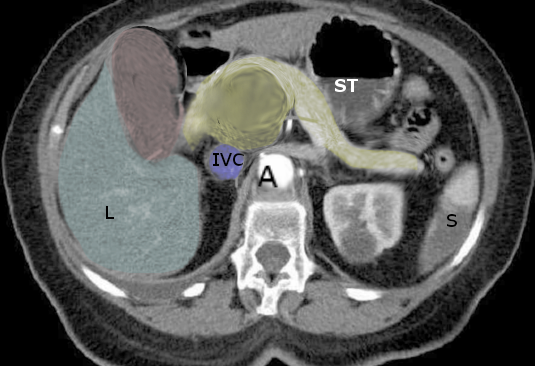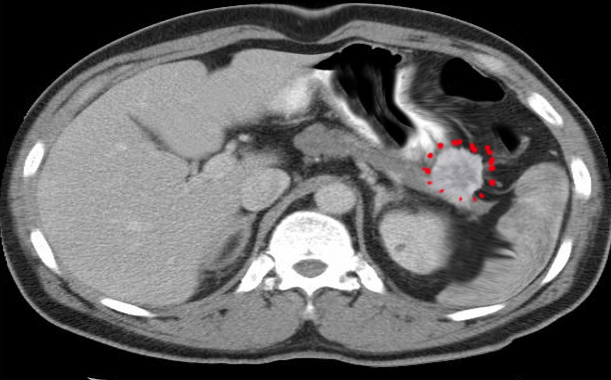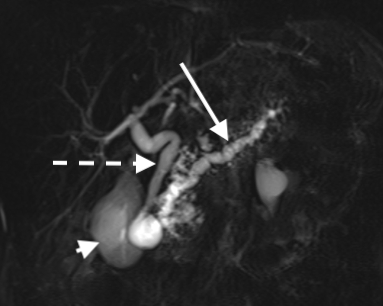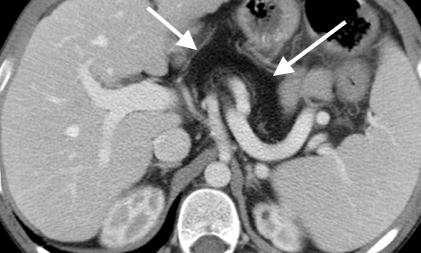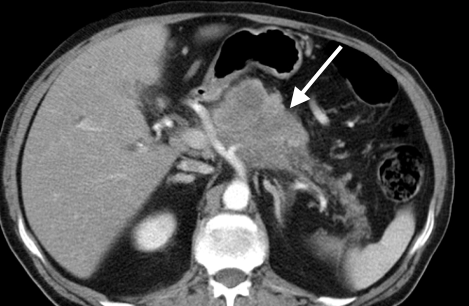[1]
Low G, Panu A, Millo N, Leen E. Multimodality imaging of neoplastic and nonneoplastic solid lesions of the pancreas. Radiographics : a review publication of the Radiological Society of North America, Inc. 2011 Jul-Aug:31(4):993-1015. doi: 10.1148/rg.314105731. Epub
[PubMed PMID: 21768235]
[2]
Shanbhogue AK, Fasih N, Surabhi VR, Doherty GP, Shanbhogue DK, Sethi SK. A clinical and radiologic review of uncommon types and causes of pancreatitis. Radiographics : a review publication of the Radiological Society of North America, Inc. 2009 Jul-Aug:29(4):1003-26. doi: 10.1148/rg.294085748. Epub
[PubMed PMID: 19605653]
[3]
Türkvatan A, Erden A, Türkoğlu MA, Seçil M, Yener Ö. Imaging of acute pancreatitis and its complications. Part 1: acute pancreatitis. Diagnostic and interventional imaging. 2015 Feb:96(2):151-60. doi: 10.1016/j.diii.2013.12.017. Epub 2014 Feb 8
[PubMed PMID: 24512896]
[4]
Forsmark CE, Baillie J, AGA Institute Clinical Practice and Economics Committee, AGA Institute Governing Board. AGA Institute technical review on acute pancreatitis. Gastroenterology. 2007 May:132(5):2022-44
[PubMed PMID: 17484894]
[5]
Yang AL, Vadhavkar S, Singh G, Omary MB. Epidemiology of alcohol-related liver and pancreatic disease in the United States. Archives of internal medicine. 2008 Mar 24:168(6):649-56. doi: 10.1001/archinte.168.6.649. Epub
[PubMed PMID: 18362258]
[6]
Thoeni RF. The revised Atlanta classification of acute pancreatitis: its importance for the radiologist and its effect on treatment. Radiology. 2012 Mar:262(3):751-64. doi: 10.1148/radiol.11110947. Epub
[PubMed PMID: 22357880]
[7]
Foster BR, Jensen KK, Bakis G, Shaaban AM, Coakley FV. Revised Atlanta Classification for Acute Pancreatitis: A Pictorial Essay. Radiographics : a review publication of the Radiological Society of North America, Inc. 2016 May-Jun:36(3):675-87. doi: 10.1148/rg.2016150097. Epub
[PubMed PMID: 27163588]
[8]
Banks PA, Freeman ML, Practice Parameters Committee of the American College of Gastroenterology. Practice guidelines in acute pancreatitis. The American journal of gastroenterology. 2006 Oct:101(10):2379-400
[PubMed PMID: 17032204]
Level 1 (high-level) evidence
[9]
Barry K. Chronic Pancreatitis: Diagnosis and Treatment. American family physician. 2018 Mar 15:97(6):385-393
[PubMed PMID: 29671537]
[10]
Capurso G, Traini M, Piciucchi M, Signoretti M, Arcidiacono PG. Exocrine pancreatic insufficiency: prevalence, diagnosis, and management. Clinical and experimental gastroenterology. 2019:12():129-139. doi: 10.2147/CEG.S168266. Epub 2019 Mar 21
[PubMed PMID: 30962702]
[11]
Mattiuzzi C, Lippi G. Current Cancer Epidemiology. Journal of epidemiology and global health. 2019 Dec:9(4):217-222. doi: 10.2991/jegh.k.191008.001. Epub
[PubMed PMID: 31854162]
[12]
Oberstein PE, Olive KP. Pancreatic cancer: why is it so hard to treat? Therapeutic advances in gastroenterology. 2013 Jul:6(4):321-37. doi: 10.1177/1756283X13478680. Epub
[PubMed PMID: 23814611]
Level 3 (low-level) evidence
[13]
Porta M, Fabregat X, Malats N, Guarner L, Carrato A, de Miguel A, Ruiz L, Jariod M, Costafreda S, Coll S, Alguacil J, Corominas JM, Solà R, Salas A, Real FX. Exocrine pancreatic cancer: symptoms at presentation and their relation to tumour site and stage. Clinical & translational oncology : official publication of the Federation of Spanish Oncology Societies and of the National Cancer Institute of Mexico. 2005 Jun:7(5):189-97
[PubMed PMID: 15960930]
[14]
Valls C, Andía E, Sanchez A, Fabregat J, Pozuelo O, Quintero JC, Serrano T, Garcia-Borobia F, Jorba R. Dual-phase helical CT of pancreatic adenocarcinoma: assessment of resectability before surgery. AJR. American journal of roentgenology. 2002 Apr:178(4):821-6
[PubMed PMID: 11906855]
[15]
McGuigan A, Kelly P, Turkington RC, Jones C, Coleman HG, McCain RS. Pancreatic cancer: A review of clinical diagnosis, epidemiology, treatment and outcomes. World journal of gastroenterology. 2018 Nov 21:24(43):4846-4861. doi: 10.3748/wjg.v24.i43.4846. Epub
[PubMed PMID: 30487695]
[16]
Klimstra DS. Nonductal neoplasms of the pancreas. Modern pathology : an official journal of the United States and Canadian Academy of Pathology, Inc. 2007 Feb:20 Suppl 1():S94-112
[PubMed PMID: 17486055]
[17]
Mizuno S, Isayama H, Nakai Y, Yoshikawa T, Ishigaki K, Matsubara S, Yamamoto N, Ijichi H, Tateishi K, Tada M, Hayashi N, Koike K. Prevalence of Pancreatic Cystic Lesions Is Associated With Diabetes Mellitus and Obesity: An Analysis of 5296 Individuals Who Underwent a Preventive Medical Examination. Pancreas. 2017 Jul:46(6):801-805. doi: 10.1097/MPA.0000000000000833. Epub
[PubMed PMID: 28609369]
[18]
Kucera JN, Kucera S, Perrin SD, Caracciolo JT, Schmulewitz N, Kedar RP. Cystic lesions of the pancreas: radiologic-endosonographic correlation. Radiographics : a review publication of the Radiological Society of North America, Inc. 2012 Nov-Dec:32(7):E283-301. doi: 10.1148/rg.327125019. Epub
[PubMed PMID: 23150863]
[19]
Strazzabosco M, Fabris L. Functional anatomy of normal bile ducts. Anatomical record (Hoboken, N.J. : 2007). 2008 Jun:291(6):653-60. doi: 10.1002/ar.20664. Epub
[PubMed PMID: 18484611]
[20]
Takano Y, Nagahama M, Maruoka N, Yamamura E, Ohike N, Norose T, Takahashi H. Clinical features of gallstone impaction at the ampulla of Vater and the effectiveness of endoscopic biliary drainage without papillotomy. Endoscopy international open. 2016 Jul:4(7):E806-11. doi: 10.1055/s-0042-109265. Epub
[PubMed PMID: 27556102]
[22]
Masiak-Segit W, Rawicz-Pruszyński K, Skórzewska M, Polkowski WP. Surgical treatment of pancreatic cancer. Polski przeglad chirurgiczny. 2018 Apr 30:90(2):45-53. doi: 10.5604/01.3001.0011.7493. Epub
[PubMed PMID: 29773761]
[23]
Kamat R, Gupta P, Rana S. Imaging in chronic pancreatitis: State of the art review. The Indian journal of radiology & imaging. 2019 Apr-Jun:29(2):201-210. doi: 10.4103/ijri.IJRI_484_18. Epub
[PubMed PMID: 31367093]
[24]
van Beek EJ, Hoffman EA. Functional imaging: CT and MRI. Clinics in chest medicine. 2008 Mar:29(1):195-216, vii. doi: 10.1016/j.ccm.2007.12.003. Epub
[PubMed PMID: 18267192]
[25]
Dimcevski G, Erchinger FG, Havre R, Gilja OH. Ultrasonography in diagnosing chronic pancreatitis: new aspects. World journal of gastroenterology. 2013 Nov 14:19(42):7247-57. doi: 10.3748/wjg.v19.i42.7247. Epub
[PubMed PMID: 24259955]
[26]
Pinho DF, Rofsky NM, Pedrosa I. Incidental pancreatic cysts: role of magnetic resonance imaging. Topics in magnetic resonance imaging : TMRI. 2014 Apr:23(2):117-28. doi: 10.1097/RMR.0000000000000018. Epub
[PubMed PMID: 24690615]
[27]
Boland GW, O'Malley ME, Saez M, Fernandez-del-Castillo C, Warshaw AL, Mueller PR. Pancreatic-phase versus portal vein-phase helical CT of the pancreas: optimal temporal window for evaluation of pancreatic adenocarcinoma. AJR. American journal of roentgenology. 1999 Mar:172(3):605-8
[PubMed PMID: 10063844]
[28]
Thoeni RF. Imaging of Acute Pancreatitis. Radiologic clinics of North America. 2015 Nov:53(6):1189-208. doi: 10.1016/j.rcl.2015.06.006. Epub 2015 Aug 5
[PubMed PMID: 26526433]
[29]
Shinagare AB, Ip IK, Raja AS, Sahni VA, Banks P, Khorasani R. Use of CT and MRI in emergency department patients with acute pancreatitis. Abdominal imaging. 2015 Feb:40(2):272-7. doi: 10.1007/s00261-014-0210-1. Epub
[PubMed PMID: 25078061]
[30]
Shyu JY, Sainani NI, Sahni VA, Chick JF, Chauhan NR, Conwell DL, Clancy TE, Banks PA, Silverman SG. Necrotizing pancreatitis: diagnosis, imaging, and intervention. Radiographics : a review publication of the Radiological Society of North America, Inc. 2014 Sep-Oct:34(5):1218-39. doi: 10.1148/rg.345130012. Epub
[PubMed PMID: 25208277]
[31]
Sahni VA, Mortelé KJ. The bloody pancreas: MDCT and MRI features of hypervascular and hemorrhagic pancreatic conditions. AJR. American journal of roentgenology. 2009 Apr:192(4):923-35. doi: 10.2214/AJR.08.1602. Epub
[PubMed PMID: 19304696]
[32]
Anaizi A, Hart PA, Conwell DL. Diagnosing Chronic Pancreatitis. Digestive diseases and sciences. 2017 Jul:62(7):1713-1720. doi: 10.1007/s10620-017-4493-2. Epub 2017 Mar 17
[PubMed PMID: 28315036]
[33]
Lavelle LP, McEvoy SH, Ni Mhurchu E, Gibney RG, McMahon CJ, Heffernan EJ, Malone DE. Cystic Fibrosis below the Diaphragm: Abdominal Findings in Adult Patients. Radiographics : a review publication of the Radiological Society of North America, Inc. 2015 May-Jun:35(3):680-95. doi: 10.1148/rg.2015140110. Epub 2015 Apr 24
[PubMed PMID: 25910185]
[34]
Brennan DD, Zamboni GA, Raptopoulos VD, Kruskal JB. Comprehensive preoperative assessment of pancreatic adenocarcinoma with 64-section volumetric CT. Radiographics : a review publication of the Radiological Society of North America, Inc. 2007 Nov-Dec:27(6):1653-66
[PubMed PMID: 18025509]
[35]
Lee ES, Lee JM. Imaging diagnosis of pancreatic cancer: a state-of-the-art review. World journal of gastroenterology. 2014 Jun 28:20(24):7864-77. doi: 10.3748/wjg.v20.i24.7864. Epub
[PubMed PMID: 24976723]
[36]
Yoon SH, Lee JM, Cho JY, Lee KB, Kim JE, Moon SK, Kim SJ, Baek JH, Kim SH, Kim SH, Lee JY, Han JK, Choi BI. Small (≤ 20 mm) pancreatic adenocarcinomas: analysis of enhancement patterns and secondary signs with multiphasic multidetector CT. Radiology. 2011 May:259(2):442-52. doi: 10.1148/radiol.11101133. Epub 2011 Mar 15
[PubMed PMID: 21406627]
[37]
Lana S, Vallara M, Bono NE, Russo G, Artioli G, Capretti G, Paladini I, Pesce A, Ruggirello M, Barbalace S, Mostardi M. MRI findings of intraductal papillary mucinous neoplasms (IPMNs). Acta bio-medica : Atenei Parmensis. 2016 Jul 28:87 Suppl 3():28-33
[PubMed PMID: 27467864]
[38]
Jang KM, Kim SH, Kim YK, Park MJ, Lee MH, Hwang J, Rhim H. Imaging features of small (≤ 3 cm) pancreatic solid tumors on gadoxetic-acid-enhanced MR imaging and diffusion-weighted imaging: an initial experience. Magnetic resonance imaging. 2012 Sep:30(7):916-25. doi: 10.1016/j.mri.2012.02.017. Epub 2012 Apr 9
[PubMed PMID: 22495239]
[39]
Kim YK, Kim CS, Han YM. Role of fat-suppressed t1-weighted magnetic resonance imaging in predicting severity and prognosis of acute pancreatitis: an intraindividual comparison with multidetector computed tomography. Journal of computer assisted tomography. 2009 Sep-Oct:33(5):651-6. doi: 10.1097/RCT.0b013e3181979282. Epub
[PubMed PMID: 19820487]
[40]
Manikkavasakar S, AlObaidy M, Busireddy KK, Ramalho M, Nilmini V, Alagiyawanna M, Semelka RC. Magnetic resonance imaging of pancreatitis: an update. World journal of gastroenterology. 2014 Oct 28:20(40):14760-77. doi: 10.3748/wjg.v20.i40.14760. Epub
[PubMed PMID: 25356038]
[41]
Parakh A, Tirkes T. Advanced imaging techniques for chronic pancreatitis. Abdominal radiology (New York). 2020 May:45(5):1420-1438. doi: 10.1007/s00261-019-02191-0. Epub
[PubMed PMID: 31428813]
[42]
Oterdoom LH, van Weyenberg SJ, de Boer NK. Double-duct sign: do not forget the gallstones. Journal of gastrointestinal and liver diseases : JGLD. 2013 Dec:22(4):447-50
[PubMed PMID: 24369328]
[43]
Herwick S, Miller FH, Keppke AL. MRI of islet cell tumors of the pancreas. AJR. American journal of roentgenology. 2006 Nov:187(5):W472-80
[PubMed PMID: 17056877]
[44]
Lee JE, Choi SY, Min JH, Yi BH, Lee MH, Kim SS, Hwang JA, Kim JH. Determining Malignant Potential of Intraductal Papillary Mucinous Neoplasm of the Pancreas: CT versus MRI by Using Revised 2017 International Consensus Guidelines. Radiology. 2019 Oct:293(1):134-143. doi: 10.1148/radiol.2019190144. Epub 2019 Sep 3
[PubMed PMID: 31478800]
Level 3 (low-level) evidence
[45]
Balthazar EJ. Acute pancreatitis: assessment of severity with clinical and CT evaluation. Radiology. 2002 Jun:223(3):603-13
[PubMed PMID: 12034923]
[46]
Iglesias-García J, Lariño-Noia J, Lindkvist B, Domínguez-Muñoz JE. Endoscopic ultrasound in the diagnosis of chronic pancreatitis. Revista espanola de enfermedades digestivas. 2015 Apr:107(4):221-8
[PubMed PMID: 25824921]
[47]
El Hajj II, LeBlanc JK, Sherman S, Al-Haddad MA, Cote GA, McHenry L, DeWitt JM. Endoscopic ultrasound-guided biopsy of pancreatic metastases: a large single-center experience. Pancreas. 2013 Apr:42(3):524-30. doi: 10.1097/MPA.0b013e31826b3acf. Epub
[PubMed PMID: 23146924]
[48]
Rust E, Hubele F, Marzano E, Goichot B, Pessaux P, Kurtz JE, Imperiale A. Nuclear medicine imaging of gastro-entero-pancreatic neuroendocrine tumors. The key role of cellular differentiation and tumor grade: from theory to clinical practice. Cancer imaging : the official publication of the International Cancer Imaging Society. 2012 May 21:12(1):173-84. doi: 10.1102/1470-7330.2012.0026. Epub 2012 May 21
[PubMed PMID: 22743056]
[49]
Hope TA, Bergsland EK, Bozkurt MF, Graham M, Heaney AP, Herrmann K, Howe JR, Kulke MH, Kunz PL, Mailman J, May L, Metz DC, Millo C, O'Dorisio S, Reidy-Lagunes DL, Soulen MC, Strosberg JR. Appropriate Use Criteria for Somatostatin Receptor PET Imaging in Neuroendocrine Tumors. Journal of nuclear medicine : official publication, Society of Nuclear Medicine. 2018 Jan:59(1):66-74. doi: 10.2967/jnumed.117.202275. Epub 2017 Oct 12
[PubMed PMID: 29025982]

